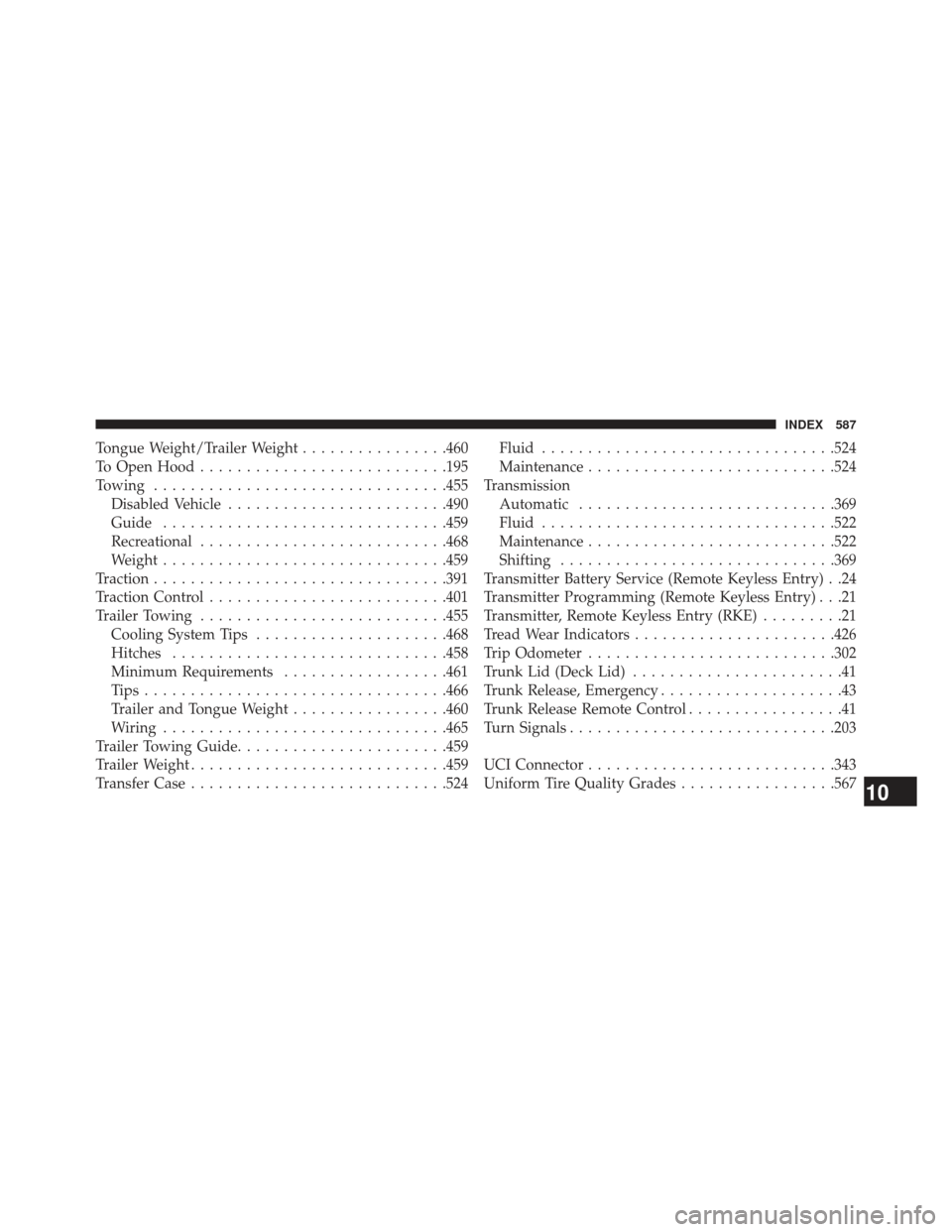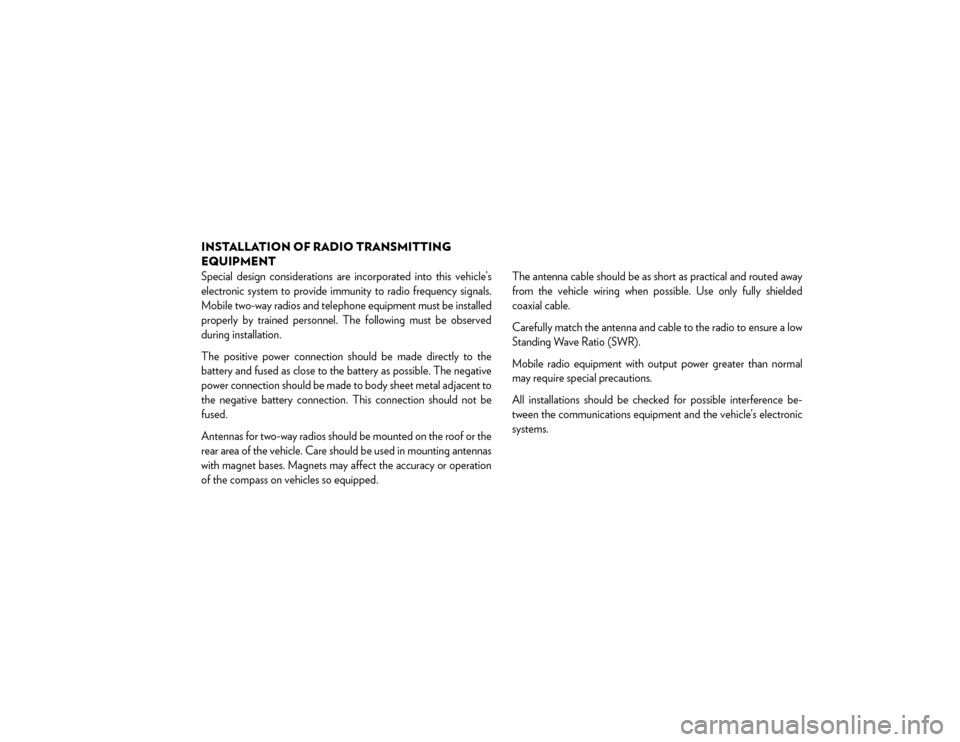Page 72 of 592

Maintaining Your Air Bag System
WARNING!
•Modifications to any part of the air bag system
could cause it to fail when you need it. You could
be injured if the air bag system is not there to
protect you. Do not modify the components or
wiring, including adding any kind of badges or
stickers to the steering wheel hub trim cover or the
upper right side of the instrument panel. Do not
modify the front bumper, vehicle body structure, or
add aftermarket side steps or running boards.
• It is dangerous to try to repair any part of the air
bag system yourself. Be sure to tell anyone who
works on your vehicle that it has an air bag system.
(Continued)
WARNING! (Continued)
•Do not attempt to modify any part of your air bag
system. The air bag may inflate accidentally or may
not function properly if modifications are made.
Take your vehicle to an authorized dealer for any
air bag system service. If your seat, including your
trim cover and cushion, needs to be serviced in any
way (including removal or loosening/tightening of
seat attachment bolts), take the vehicle to your
authorized dealer. Only manufacturer approved
seat accessories may be used. If it is necessary to
modify the air bag system for persons with dis-
abilities, contact your authorized dealer.
70 THINGS TO KNOW BEFORE STARTING YOUR VEHICLE
Page 73 of 592

Air Bag Warning Light
You will want to have the air bags ready to
inflate for your protection in a collision. The
Air Bag Warning Light monitors the internal
circuits and interconnecting wiring associated
with air bag system electrical components. While the air
bag system is designed to be maintenance free. If any of
the following occurs, have an authorized dealer service
the air bag system immediately.
• The Air Bag Warning Light does not come on during
the four to eight seconds when the ignition is first
cycled to the ON/RUN.
• The Air Bag Warning Light remains on after the four to
eight-second interval.
• The Air Bag Warning Light comes on intermittently or
remains on while driving. NOTE:
If the speedometer, tachometer, or any engine
related gauges are not working, the Occupant Restraint
Controller (ORC) may also be disabled. The air bags may
not be ready to inflate for your protection. Promptly
check the fuse block for blown fuses. Refer to “Fuses” in
“Maintaining Your Vehicle” for the proper air bag fuses.
See your authorized dealer if the fuse is good.
Event Data Recorder (EDR)
This vehicle is equipped with an event data recorder
(EDR). The main purpose of an EDR is to record, in
certain crash or near crash-like situations, such as an air
bag deployment or hitting a road obstacle, data that will
assist in understanding how a vehicle’s systems per-
formed. The EDR is designed to record data related to
vehicle dynamics and safety systems for a short period of
2
THINGS TO KNOW BEFORE STARTING YOUR VEHICLE 71
Page 467 of 592
Towing Requirements – Trailer Lights And Wiring
Whenever you pull a trailer, regardless of the trailer size,
stoplights and turn signals on the trailer are required for
motoring safety.
The Trailer Tow Package may include a four- and seven-
pin wiring harness. Use a factory approved trailer har-
ness and connector.
NOTE:Do not cut or splice wiring into the vehicles
wiring harness.
The electrical connections are all complete to the vehicle
but you must mate the harness to a trailer connector.
Refer to the following illustrations.
Four-Pin Connector
1 — Female Pins 4 — Park
2 — Male Pin 5 — Left Stop/Turn
3 — Ground 6 — Right Stop/Turn
5
STARTING AND OPERATING 465
Page 589 of 592

Tongue Weight/Trailer Weight................460
To Open Hood .......................... .195
Towing ............................... .455
Disabled Vehicle ....................... .490
Guide .............................. .459
Recreational .......................... .468
Weight .............................. .459
Traction ............................... .391
Traction Control ......................... .401
Trailer Towing .......................... .455
Cooling System Tips .....................468
Hitches ............................. .458
Minimum Requirements ..................461
Tips................................ .466
Trailer and Tongue Weight .................460
Wiring .............................. .465
Trailer Towing Guide ...................... .459
Trailer Weight ........................... .459
Transfer Case ........................... .524Fluid
............................... .524
Maintenance .......................... .524
Transmission Automatic ........................... .369
Fluid ............................... .522
Maintenance .......................... .522
Shifting ............................. .369
Transmitter Battery Service (Remote Keyless Entry) . .24
Transmitter Programming (Remote Keyless Entry) . . .21
Transmitter, Remote Keyless Entry (RKE) .........21
Tread Wear Indicators ..................... .426
Trip Odometer .......................... .302
Trunk Lid (Deck Lid) .......................41
Trunk Release, Emergency ....................43
Trunk Release Remote Control .................41
Turn Signals ............................ .203
UCI Connector .......................... .343
Uniform Tire Quality Grades .................567
10
INDEX 587
Page 591 of 592

INSTALLATION OF RADIO TRANSMITTING
EQUIPMENTSpecial design considerations are incorporated into this vehicle’s
electronic system to provide immunity to radio frequency signals.
Mobile two-way radios and telephone equipment must be installed
properly by trained personnel. The following must be observed
during installation.
The positive power connection should be made directly to the
battery and fused as close to the battery as possible. The negative
power connection should be made to body sheet metal adjacent to
the negative battery connection. This connection should not be
fused.
Antennas for two-way radios should be mounted on the roof or the
rear area of the vehicle. Care should be used in mounting antennas
with magnet bases. Magnets may affect the accuracy or operation
of the compass on vehicles so equipped.The antenna cable should be as short as practical and routed away
from the vehicle wiring when possible. Use only fully shielded
coaxial cable.
Carefully match the antenna and cable to the radio to ensure a low
Standing Wave Ratio (SWR).
Mobile radio equipment with output power greater than normal
may require special precautions.
All installations should be checked for possible interference be-
tween the communications equipment and the vehicle’s electronic
systems.